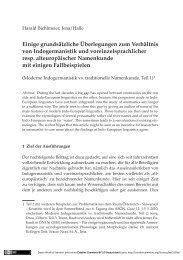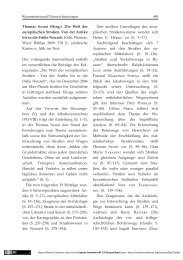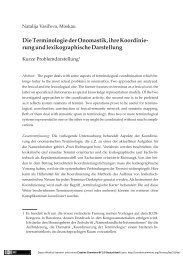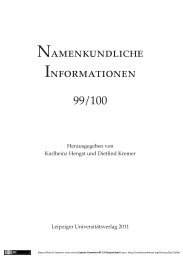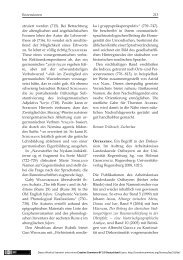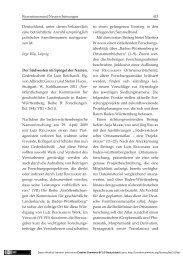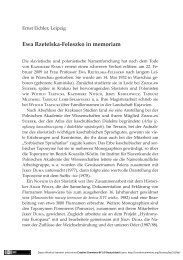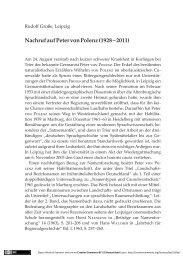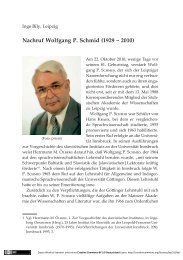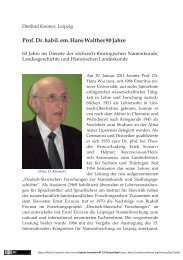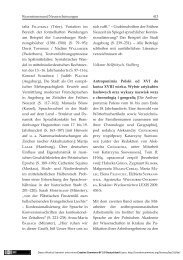Proper Names in the Light of Theoretical Onomastics
Proper Names in the Light of Theoretical Onomastics
Proper Names in the Light of Theoretical Onomastics
Create successful ePaper yourself
Turn your PDF publications into a flip-book with our unique Google optimized e-Paper software.
<strong>Proper</strong> <strong>Names</strong> In <strong>the</strong> <strong>Light</strong> <strong>of</strong> <strong>Theoretical</strong> <strong>Onomastics</strong>133Pavel Bročko (Rakovo) Paľo Bročké K + RM=PK + P Jirka Hoľík CH vInžiňierAlkohoľikCH zCH vThe established set <strong>of</strong> metal<strong>in</strong>gual components which constitute <strong>the</strong> contentaspect <strong>of</strong> anthroponymic signs facilitates an <strong>in</strong>sight <strong>in</strong>to an <strong>in</strong>ternalstructure <strong>of</strong> microsystems and macro-systems <strong>of</strong> liv<strong>in</strong>g personal names. Inalmost two thirds <strong>of</strong> <strong>the</strong> villages exam<strong>in</strong>ed <strong>in</strong> Central Slovakia, <strong>the</strong> liv<strong>in</strong>gnames with a frequency <strong>of</strong> “1” constitute more than half <strong>of</strong> all nam<strong>in</strong>gtypes; <strong>the</strong>se names are marg<strong>in</strong>al. A high percentage <strong>of</strong> liv<strong>in</strong>g names isusually concentrated around 7–10 nam<strong>in</strong>g types. These names have a centralposition <strong>in</strong> a given microsystem. In cartographic process<strong>in</strong>g not onlynam<strong>in</strong>g types and models are used but also <strong>the</strong>ir components. For example,central as well as marg<strong>in</strong>al content models have <strong>the</strong>ir specific geographicalareas. The construction, development and function<strong>in</strong>g <strong>of</strong> un<strong>of</strong>ficialnam<strong>in</strong>g cannot be isolated from <strong>the</strong> <strong>of</strong>ficial nam<strong>in</strong>g system but <strong>the</strong>irformation and fur<strong>the</strong>r development have <strong>the</strong>ir own direction. In liv<strong>in</strong>gnames we have discovered some nam<strong>in</strong>g pr<strong>in</strong>ciples which are not knownto <strong>the</strong> <strong>of</strong>ficial system (<strong>the</strong>y are new laws <strong>of</strong> liv<strong>in</strong>g names <strong>in</strong> deep structure),e. g. a person is named after his or her <strong>in</strong>dividual characteristic or<strong>in</strong>directly, i. e. <strong>in</strong> relation to ano<strong>the</strong>r, usually related person; <strong>the</strong> nam<strong>in</strong>g <strong>of</strong>a member <strong>of</strong> a family can be motivated by a name <strong>of</strong> a courtyard; a name<strong>of</strong> a mo<strong>the</strong>r-breeder can be <strong>the</strong> start<strong>in</strong>g po<strong>in</strong>t for nam<strong>in</strong>g <strong>in</strong> a family. Similarf<strong>in</strong>d<strong>in</strong>gs with regard to <strong>the</strong> nam<strong>in</strong>g <strong>of</strong> family members after <strong>the</strong> mo<strong>the</strong>r<strong>in</strong> <strong>the</strong> territory <strong>of</strong> Western Lemki were published by Wolnicz-Pawłowskaand by P. Čučka <strong>in</strong> Hutsul villages <strong>in</strong> <strong>the</strong> Transcarpathian region. Theclassification <strong>of</strong> extensive material and f<strong>in</strong>d<strong>in</strong>gs on <strong>the</strong> frequency and geographicaldistribution <strong>of</strong> content models <strong>of</strong> liv<strong>in</strong>g personal names has created<strong>the</strong> conditions for a comparative socio-l<strong>in</strong>guistic analysis <strong>of</strong> generalnam<strong>in</strong>g pr<strong>in</strong>ciples <strong>of</strong> liv<strong>in</strong>g names <strong>in</strong> related and unrelated languages(fur<strong>the</strong>r detail: Blanár/Matejčík 1978 / 83; Blanár 1996).In contact situations, personal nam<strong>in</strong>g f<strong>in</strong>ds itself <strong>in</strong> various <strong>in</strong>terferencerelations. These relations are manifested not only <strong>in</strong> <strong>the</strong> nam<strong>in</strong>gmotives <strong>in</strong> onymically relevant features but also <strong>in</strong> <strong>the</strong> nam<strong>in</strong>g pr<strong>in</strong>ciples<strong>the</strong>mselves. Let us give an example <strong>of</strong> Slovak-Hungarian contacts. In <strong>the</strong>account<strong>in</strong>g books <strong>of</strong> <strong>the</strong> yeoman m<strong>in</strong>e court <strong>in</strong> Boca from 1588 –1602, we



